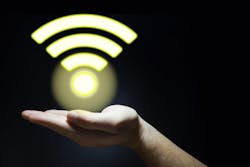White paper describes LiFi’s benefits, challenges
The document titled “What is LiFi?” is available through CABA’s free research library. The document is authored by J.B. Groves of Wharton County Junior College.
After spending a handful of pages explaining what LiFi is, how it works, and fundamental differences between LiFi and WiFi, the paper from CABA compares RF wireless and optical wireless technologies. It then provides information on related IEEE and ITU standards, before describing LiFi’s benefits, disadvantages, and applications.
“LiFi could enable data for laptops, smartphones, and tablets to be transmitted through the LED lighting in a room using light-emitting diodes pulsing at extremely high speeds, undetectable to the human eye,” the paper says. “A complete LiFi network includes downlink, uplink, and backhaul connections. In addition, the system should provide a handover function, mobility support, and multiple access capabilities.”
Stating that LiFi is complementary to all WiFi technologies, the document compares the characteristics of optical wireless technology deployed via LiFi, to the radio-frequency wireless technology deployed via WiFi. It does so for features including means of operation, interference, privacy/security, and data density.
The document also includes a glossary of terms associated with LiFi.
